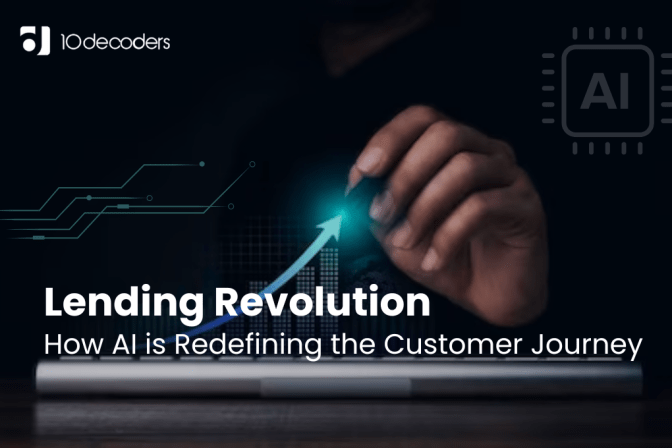Lending Revolution: How AI is Redefining the Customer Journey
The lending industry, once synonymous with cumbersome paperwork and lengthy approval processes, is undergoing a paradigm shift. Artificial intelligence (AI) is emerging as the driving force in this revolution, transforming the customer journey and creating a more personalised, efficient, and accessible financial experience.
Traditional Pain Points
Traditionally, the customer journey in lending has been fraught with friction. Borrowers face
- Time-consuming applications: Paper forms, manual data verification, and lengthy underwriting processes lead to frustration and delays.
- Limited access to credit: Rigid credit scoring models often exclude individuals with thin credit files or alternative income sources.
- Opaque decision-making: Lack of transparency in loan approvals and interest rates can leave borrowers feeling uninformed and powerless.
- Limited interaction and support: Traditional lending models lack the 24/7 availability and personalised support that modern customers demand.
AI as the Catalyst for Change
AI is injecting intelligence into the lending ecosystem, addressing these pain points and fundamentally reshaping the customer journey
- Streamlined applications: AI-powered chatbots and online portals guide customers through the application process, collecting data efficiently and minimising errors.
- Alternative data insights: AI analyses alternative data sources like social media activity and mobile phone usage, providing a more holistic view of a borrower’s financial health and creditworthiness.
- Real-time risk assessment: Advanced algorithms analyse vast datasets to generate accurate credit scores and risk assessments in real-time, enabling faster loan approvals.
- Dynamic decision-making: AI models adapt to changing market conditions and individual circumstances, allowing for flexible and personalised loan terms and interest rates.
- Personalised customer support: AI-powered chatbots and virtual assistants provide 24/7 support, answer questions, and offer guidance throughout the loan journey.
The Result: A Customer-Centric Benefits
This AI-powered transformation fosters a customer journey characterised by
- Faster and Efficient Loan Processing: Applications are approved within minutes or hours, eliminating lengthy waits and transforming uncertainty into a quick, decisive resolution.
- Greater Access to Credit: Previously excluded individuals with non-traditional credit profiles gain access to financial resources, promoting financial inclusion and economic growth. Imagine democratising the financial system, allowing everyone to participate in the economic orchestra.
- Increased Transparency and Trust: Explainable AI models shed light on decision-making processes, fostering trust and empowering borrowers with knowledge. Imagine loan approvals not as pronouncements from an abstract authority, but as transparent compositions played out for all to understand.
- Personalized Financial Solutions: Loan products and services are no longer cookie-cutter offerings. AI creates financial solutions tailored to individual needs and circumstances, ensuring each borrower receives a loan that complements their unique financial score.
- Continuous Support and Engagement: Borrowers are no longer alone in their financial journey. AI-powered tools and resources provide ongoing guidance and support, building long-term relationships and fostering financial literacy. Imagine financial support not as a sporadic encore, but as an ever-present melody accompanying borrowers every step of the way.
Challenges and Considerations: The Unfinished Movement
This AI-led revolution, like any grand symphony, requires careful attention to ensure harmony and avoid dissonance
- Algorithmic Bias: Unbiased data and algorithms are crucial to prevent discriminatory lending practices. The orchestra of financial opportunity must play for everyone, not just a select few.
- Data Privacy and Security: Robust security measures and adherence to data privacy regulations are essential to protect sensitive customer information. The melody of trust must remain clear and untarnished.
- Human-in-the-loop Approach: AI should complement, not replace, human expertise. Responsible lending practices and ethical considerations ensure the composition remains balanced, with both technology and human judgement contributing to the harmony.
- Explainable AI: Transparency and explainability in AI models are crucial to build trust and address potential concerns about automation. The financial journey should unfold like a transparent score, readily understood by all participants.
Conclusion
AI is not just transforming the lending industry; it is reshaping how we interact with financial services altogether. By embracing its potential while addressing the challenges, lenders can create a customer-centric lending ecosystem that is faster, fairer, and more personalised. This revolution will not only benefit borrowers with improved access to credit and a seamless financial experience, but also empower lenders to unlock new opportunities and drive sustainable growth. As AI continues to evolve, the future of lending lies in harnessing its power to create a more inclusive, accessible, and human-centred financial landscape for all.



